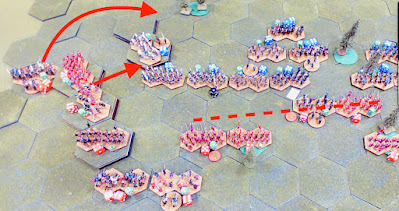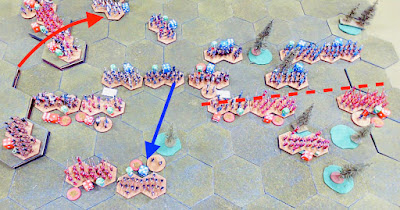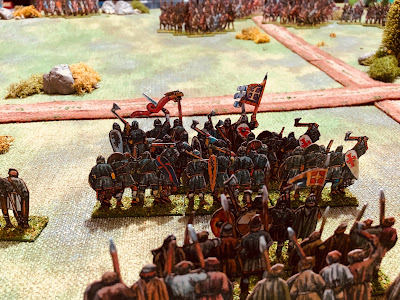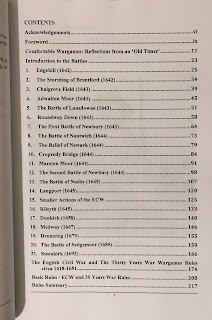My tabletop is 6x4 foot and suits me fine for pretty much most of my wargaming with armies of between 6 to 10 units. If find these games perfectly enjoyable, but do not necessarily give you the feel of a big battle. This is particularly true of the Horse and Musket period. Having no desire to make a bigger tabletop or purchase and paint the necessary figures, I decided to try and run a big battle like a campaign. I remembered a chapter called "A Corps Campaign (Napoleonic)" in "War Game Campaigns" by Donald Featherstone. The chapter is a short 6 pages and are the inspiration for these Battle Campaign rules.
 |
| The drafted map of the battlefield |
This and following posts will detail the campaign rules, the games representing actions in the battle, and any amendments I find necessary as the battle campaign progresses.
Drawing the map
The first step is to draw up the map. The map is divided up into four lanes which are assigned to one of the army corps which can move up and down the lanes, but never side to side. Each army has three Corps and an Army Reserve which never appears on the map. The three Corps start the game in the deployment zones row 2 or 4 and must depending which side of the map they are defending. All Corps must be all adjacent so one lane, lane 1 or lane 4, will remain unoccupied.
 |
| Deployment zones and map lanes. |
 |
| An example of two forces deployed, both with unopposed flanks. |
After deployment there is a good chance that each side will have an unopposed flanking force. More on how the unopposed Corps are used later on. During the campaign turn players take turns to move one Corps up or down a lane or take a pass on moving. When two opposing forces are next to each other in a lane the map features transferred to the tabletop and an action is fought.
 |
| During Red Army's turn they choose to advance Corps I who make contact with Blue's Corps II. This now has to be transferred to the tabletop. |
 |
| Moving the counters reveals the terrain to be fought over. Each square represents 2x2 foot on a 6x4 foot tabletop. |
The area covered by the counters is transferred to the wargaming table. To assist this the map has dotted lines added which help define a 2x2 foot square on the tabletop.
 |
| An example of the above map section transferred to the tabletop. |
The action will then be fought using the units available to the Corps involved. As the game progresses additional units can be brought into the game to replace loses from reserves arriving on the base edge or on the flank if there is an unopposed Corps. The over-arching rules are:
- A player can never be more than 8 units on the table
- Units that arrive to replace eliminated units are never returned and remain with the corps for the remainder of the campaign.
- Eliminated units are also lost to the campaign.
 |
| Red Corps I can receive reserves and Blue Corps II can receive reserves or flanking units from Corps I. Flanking units can arrive anywhere on the tabletop side and Army Reserves on the base edge. |
The actions on the tabletop are played using One Hour Wargames Horse and Musket rules over 15 turns. The winner of the action remains in position on the campaign map and the loser must retire one step.
 |
| In this example action, Red Corps I won the action and remain in place and the losing Blue Corps II retires one step. |
The battle campaign is won by forcing one of the opposing Corps off the map. Conserving units in the tabletop games and timely use of reserves will be important to obtaining victory.
Deciding the units for each Corps and Army Reserve
Having drawn the map the next step is to decide the unit make up of each corps and the reserves. This can be decided using dice or creating three lists and randomly assigning them to each corps. The army reserve also needs to be decided and I have opted for an even split of infantry and cavalry units. The constraint I have to apply is the number of units of a certain type I can field on the tabletop.
As with most campaigns there is a level of bookkeeping to track of units eliminated on the tabletop and where units are moved to a corps with from reserves or from an unopposed flanking corps. I am using a table below the map with a square for each unit. When eliminated it is crossed out, and when moved in is also crossed out and a new square drawn on the corps it has joined.
 |
| Bookkeeping is done below the map so no loose pieces of paper to worry about. |
Campaign Rules
To start the campaign both players write down which three lines they will deploy their corps. The corps must be adjacent to each other. They then place the counters in the deployment rows.
Dice to decide which player moves one unit first. Players then take turns to move one unit as a time.
Whenever two opposing units in a line are adjacent then the action is taken to the tabletop.
During the game whenever a player has a unit eliminated they have the option of moving up a reserve unit to join the tabletop game. If they arrive from reserves then they are placed on the base edge and if from an unopposed corps they arrive the flank edge.
Any units eliminated on the tabletop are lost to the action and battle campaign.
The loser of the action must retire one step in their map lane. If this pushes them off the map, then the battle is lost. If the action is inconclusive, then the attacking corps retires one step.
In the next post I will cover off what determines whether actions are won or lost on the tabletop.

















































